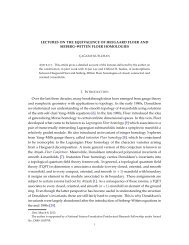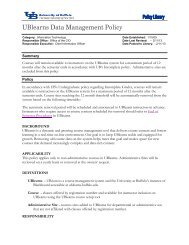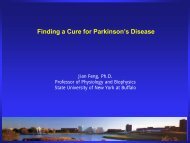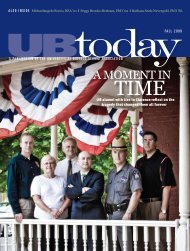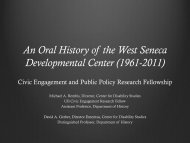Reaching Others - University at Buffalo
Reaching Others - University at Buffalo
Reaching Others - University at Buffalo
You also want an ePaper? Increase the reach of your titles
YUMPU automatically turns print PDFs into web optimized ePapers that Google loves.
gradu<strong>at</strong>ion 2009<br />
<strong>Reaching</strong> <strong>Others</strong><br />
Perhaps more than in any profession, social workers are able by touching one life<br />
to improve the lives of many; by empowering one person, to change the lives of<br />
families and neighbors; by empowering one group, to send change rippling through<br />
neighborhoods, organiz<strong>at</strong>ions, communities, and n<strong>at</strong>ions.<br />
In 2009, the School of Social Work gradu<strong>at</strong>ed 181 professional MSWs and three<br />
PhDs in social welfare, all committed to making a difference.<br />
Wh<strong>at</strong> follows are the stories of three new MSWs who represent<br />
the best of who we are as a school and a profession.<br />
6 mosaics : Summer 2009
gradu<strong>at</strong>ion 2009<br />
Older and Wiser<br />
Peter Firestone, BA/MSW<br />
Straight out of high school, Peter Firestone spent<br />
six years working with youth in community centers and<br />
schools in several South Side and West Side neighborhoods<br />
of Chicago. Realizing there was a limit to wh<strong>at</strong> he could<br />
do in the world of human services with a high school degree, he<br />
decided to return to his n<strong>at</strong>ive <strong>Buffalo</strong> and go back to school.<br />
“My interest was how to make organiz<strong>at</strong>ions work better,<br />
how to make projects serve people better,” he says.<br />
Firestone enrolled in the BA/MSW program <strong>at</strong> UB. In the<br />
MSW program he started working with an aging popul<strong>at</strong>ion.<br />
“At first you want to say th<strong>at</strong> you know wh<strong>at</strong> you want to do,”<br />
helping them to pull those things out. Listening is huge. And being<br />
there as one who’s willing to advoc<strong>at</strong>e—because a lot of times<br />
seniors are just shuffled around.”<br />
An example of this occurred during Firestone’s fieldwork<br />
when it became apparent th<strong>at</strong> a client was being placed into a<br />
completely inappropri<strong>at</strong>e level of care.<br />
“A<br />
woman who came into a nursing facility for<br />
rehabilit<strong>at</strong>ion after a fall wanted to go home,” Firestone<br />
recounts. “But someone decided th<strong>at</strong> she was confused<br />
and belonged in a dementia unit. She was justifiably disoriented<br />
he says, “but there is wisdom in the school’s plan to fill in the gaps<br />
of your experience. You become more well-rounded.”<br />
Indeed, he found a new calling through an internship <strong>at</strong><br />
the nearby Weinberg Campus, a senior living community with a<br />
pioneering aging-in-place program th<strong>at</strong> aims to keep frail older<br />
people living independently in the community.<br />
Firestone pursued this interest in an advanced-year field<br />
placement th<strong>at</strong> was part of the school’s Hartford Partnership<br />
Program in Aging Educ<strong>at</strong>ion, a field educ<strong>at</strong>ion model th<strong>at</strong> rot<strong>at</strong>es<br />
students through different parts of a single program or agency so<br />
they gain a rich perspective of the full spectrum of aging and of<br />
the diverse services th<strong>at</strong> older adults and their caregivers need.<br />
“It is a comprehensive program for building competency in<br />
all disciplines for geri<strong>at</strong>ric work,” he says, “giving you opportunities<br />
to interact with hospice, hospitals,<br />
senior centers, and the VA, and talking<br />
about dementia, end-of-life care, policy,<br />
substance abuse, veterans’ issues, and any<br />
issue th<strong>at</strong> intersects with aging.”<br />
Attention to the individual is the<br />
primary focus. “We assume older people<br />
have all these problems instead of looking<br />
for their strengths,” Firestone says. “There’s<br />
a c<strong>at</strong>ch phrase in social work th<strong>at</strong> people<br />
are experts on their own problems. They<br />
know wh<strong>at</strong> they’re going through. They<br />
know wh<strong>at</strong> they’ve tried. They know wh<strong>at</strong>’s<br />
failed. So it’s really about honoring the<br />
because she had been shuffled from a hospital to rehab to a<br />
dementia bed in the course of just a few days, with little or no<br />
explan<strong>at</strong>ion. After sitting with her and actually taking the time<br />
to evalu<strong>at</strong>e her situ<strong>at</strong>ion, we saw this was the source of her agit<strong>at</strong>ion<br />
and confusion. This woman was a refugee who fled from<br />
the Nazis in World War II—can you imagine why she was now<br />
concerned about being held hostage?”<br />
Firestone is committed to the <strong>Buffalo</strong> area and to finding a<br />
position in the new order of aging care.<br />
Firestone says th<strong>at</strong> his UB experience prepared him well for<br />
the road ahead. “The School of Social Work program challenged<br />
who I am as a professional and helped me grow in th<strong>at</strong> regard,” he<br />
says. “You come out of it with a certain confidence. When you’re<br />
first starting out in social work, you have this idea th<strong>at</strong> there’s a<br />
formula for helping people or communities,<br />
some magic piece of knowledge. Wh<strong>at</strong><br />
you really learn is th<strong>at</strong> while you approach<br />
everything with a theoretical framework,<br />
people and communities are dynamic, and<br />
the problems they face are dynamic, so you<br />
have to be cre<strong>at</strong>ive about helping to solve<br />
those problems. You can’t just rely on wh<strong>at</strong><br />
you think may work, or even wh<strong>at</strong> has<br />
worked somewhere else.<br />
“The joy in the work is finding the<br />
way to help people. I came away with an<br />
understanding of systems and issues th<strong>at</strong> I<br />
wouldn’t have necessarily pursued on my<br />
person’s individuality and strengths and<br />
own.”<br />
—J.B.<br />
Peter Firestone<br />
mosaics : Summer 2009 7
gradu<strong>at</strong>ion 2009<br />
Honor the story<br />
Richard Conheady, msw<br />
Some students enter MSW study directly from college.<br />
Many come with a few years of ground-level experience<br />
in social services, sure now of their career choice; some<br />
come to change careers.<br />
Richard Conheady came with 15 years of progressively more<br />
challenging social services experience.<br />
He answered the call of social conscience in 1991 and has<br />
worked with people in need ever since. His MSW studies confirmed<br />
wh<strong>at</strong> he’d learned along the way and equipped him with<br />
new skills.<br />
Conheady started his social service career with a churchbased<br />
outreach to ex-offenders, first managing a restaurant th<strong>at</strong><br />
was part of a work reorient<strong>at</strong>ion program for recently released offenders,<br />
then leading counseling groups in correctional facilities<br />
and eventually running a residential services facility for released<br />
offenders. He’d been an ornamental horticulturalist for 10 years<br />
when joining Rochester’s socially active Corpus Christi Church<br />
set him on a different road.<br />
After seven years of learning on the job, he decided he<br />
needed a degree—“I thought I’d better get some educ<strong>at</strong>ion.” He<br />
knew there would be too many doors closed to him without one.<br />
So he enrolled <strong>at</strong> SUNY-Brockport, gradu<strong>at</strong>ing four years l<strong>at</strong>er<br />
with a BSW. He added another stop in his professional development<br />
with a field placement with the Spiritus Christi Mental<br />
Health Center.<br />
Newly credentialed, he went to work<br />
for the Cayuga Home for Children in Monroe<br />
County, among other things helping<br />
the agency develop outcome measures for<br />
its functional family therapy program. He<br />
was eventually made program coordin<strong>at</strong>or.<br />
He enrolled in the MSW program<br />
when the clock was about to run out on his<br />
advance-standing option. (Th<strong>at</strong> he received<br />
an A- in an otherwise perfect academic<br />
record <strong>at</strong> UB indic<strong>at</strong>es th<strong>at</strong> he did still have<br />
something to learn!)<br />
Actually, wh<strong>at</strong> Conheady wants to<br />
learn more about <strong>at</strong> this stage is narr<strong>at</strong>ive<br />
therapy, which he was introduced to<br />
by a colleague early in his career and then practiced during his<br />
undergradu<strong>at</strong>e fieldwork and again in his MSW field placement<br />
<strong>at</strong> St. Joseph’s Neighborhood Center in Rochester. St. Joseph’s<br />
provides comprehensive health care, counseling, adult educ<strong>at</strong>ion<br />
and social work services for individuals and families who lack<br />
access to health insurance.<br />
Because the center serves the uninsured, it doesn’t have to<br />
march to any insurer’s tempo and so it is free to use a poststructuralist<br />
practice such as narr<strong>at</strong>ive therapy th<strong>at</strong> is too new to have<br />
the kind of replic<strong>at</strong>ed outcome studies th<strong>at</strong> payers need to see.<br />
For Conheady, whose social work career has been the<br />
realiz<strong>at</strong>ion of the voc<strong>at</strong>ion he found in himself, there is a<br />
n<strong>at</strong>ural appeal in a therapeutic model founded on helping<br />
clients develop the “story” of their skills and abilities. As in other<br />
models, the therapist recognizes th<strong>at</strong> the client is the expert in his<br />
or her life. Unlike solution-focused therapies th<strong>at</strong> are organized<br />
by problem, narr<strong>at</strong>ive therapy seeks to discover the story line the<br />
client can use to solve problems.<br />
Ironically, the MSW program taught him models he knows<br />
he doesn’t want to use. And it formalized and sharpened his critical<br />
thinking. So now he can develop his skills in a nonstructuralist<br />
approach to therapy, knowing where it fits in the universe of<br />
available therapies, and confident in his reasons for preferring it.<br />
Moreover, he’d like to contribute to the body of understanding<br />
about narr<strong>at</strong>ive therapy by using an<br />
evalu<strong>at</strong>ion process to measure its effectiveness.<br />
As he surveys the available opportunities<br />
<strong>at</strong> the point of resuming his career,<br />
Richard Conheady says he will continue to<br />
work with underserved popul<strong>at</strong>ions; he’d<br />
like to combine working for a nonprofit<br />
agency with priv<strong>at</strong>e practice. And maybe<br />
teach. “I’d love to develop a course around<br />
nonstructuralist therapy.”<br />
Since past performance is a good<br />
predictor of future performance, th<strong>at</strong>’s a<br />
course you may find in the Rochester area<br />
someday soon.<br />
—J.M.<br />
Richard Conheady<br />
8 mosaics : Summer 2009
gradu<strong>at</strong>ion 2009<br />
Doubly armed<br />
Mandy Teeter, MSW/MBA<br />
How many pl<strong>at</strong>es can one person spin successfully?<br />
More than you’d guess, if th<strong>at</strong> person is Mandy Teeter.<br />
Teeter is a mother, wife and an accredited addictions<br />
therapist living and working just outside Rochester, N.Y.<br />
As of this May, she is also the first to gradu<strong>at</strong>e from the School of<br />
Social Work with a combined MSW/MBA degree.<br />
“It’s been wonderful—r<strong>at</strong>her tough and challenging <strong>at</strong><br />
times—but rewarding,” Teeter says of the dual degree. While she<br />
worked part-time in Rochester as an alcohol and substance abuse<br />
counselor, she commuted daily to her full-time gradu<strong>at</strong>e school<br />
programs in <strong>Buffalo</strong>.<br />
The MSW/MBA is a three-year program. Taken separ<strong>at</strong>ely,<br />
the degrees would require four years to complete. Credit hours<br />
are split between the two schools, with two joint internships.<br />
Teeter always planned to go to gradu<strong>at</strong>e school after earning<br />
her undergradu<strong>at</strong>e degree, but chose to work for a few years<br />
until she knew exactly wh<strong>at</strong> she wanted to study—and why. She<br />
eventually began researching schools with interdisciplinary and<br />
combined programs in social work and business.<br />
“I knew the MSW would give me the clinical side,” she says,<br />
“and a found<strong>at</strong>ion in evidence-based research. But I also realized<br />
th<strong>at</strong> an MBA could give me useful exposure to business and management<br />
principles.” UB was the only school in New York offering<br />
the combin<strong>at</strong>ion, and since it was only an hour away, she decided<br />
to take the plunge and apply.<br />
Teeter says th<strong>at</strong> in the addictions field,<br />
the focus tends to be on the individual. She<br />
wanted to look holistically <strong>at</strong> intervention<br />
programs th<strong>at</strong> are more collabor<strong>at</strong>ive and<br />
better suited to her goal of becoming a social<br />
services administr<strong>at</strong>or in the nonprofit<br />
or local government sector.<br />
“Ideally, I see myself <strong>at</strong> the administr<strong>at</strong>ive<br />
level, working on transforming<br />
systems of care and services delivery,” Teeter<br />
says. She’d like to consult on evalu<strong>at</strong>ion<br />
d<strong>at</strong>a for a health department or nonprofit<br />
serving a regional popul<strong>at</strong>ion. “I’ve learned<br />
th<strong>at</strong> you can’t really improve health care<br />
services until you’ve collected all the d<strong>at</strong>a.”<br />
Teeter’s two internships were (MBA) <strong>at</strong> the Associ<strong>at</strong>ion<br />
for the Blind and Visually Impaired-Goodwill in Rochester,<br />
where she researched Medicaid policy and reimbursements; and<br />
(MSW) <strong>at</strong> the Monroe County Office of Mental Health, where<br />
she worked on developing assessment tools and an integr<strong>at</strong>ed<br />
care plan for a Rochester-based mental health and chemical dependency<br />
services provider. In both internships, Teeter collected<br />
and organized health d<strong>at</strong>a to make it more accessible and useful<br />
for each agency.<br />
Howard J. Doueck, professor and associ<strong>at</strong>e dean for academic<br />
affairs, served as Teeter’s advisor during the three-year<br />
program, and helped her pioneer the dual degree, along with<br />
Diane E. Elze, associ<strong>at</strong>e professor and director of the MSW<br />
program, and K<strong>at</strong>hleen Kost, former associ<strong>at</strong>e dean for academic<br />
affairs. They charted which courses were available and when,<br />
and pointed Teeter to the people with the answers for scheduling<br />
courses and internships.<br />
Teeter spent the first semester adjusting to the<br />
quantit<strong>at</strong>ive courses in management and getting a general<br />
feel for the vocabulary and culture of business school. “It<br />
was like a different world from behavioral health, with its own<br />
language,” she says.<br />
By her third year, having both social work and management<br />
courses under her belt, Teeter was comfortable, and began to<br />
fully appreci<strong>at</strong>e how each degree informed<br />
the other.<br />
“We often see people with clinical—<br />
but not financial or managerial—backgrounds<br />
running nonprofit agencies, and<br />
it may not always be a good fit. If you have<br />
a background in both management and social<br />
work, you’re prepared for the variety of<br />
responsibilities th<strong>at</strong> leadership <strong>at</strong> th<strong>at</strong> level<br />
must deal with,” Doueck says.<br />
Teeter is looking <strong>at</strong> Rochester-area<br />
nonprofits to see which ones fit her unique<br />
skill sets. The pl<strong>at</strong>es are still spinning and<br />
she feels empowered to keep them going.<br />
—L.N.M.<br />
Mandy Teeter<br />
mosaics : Summer 2009 9



